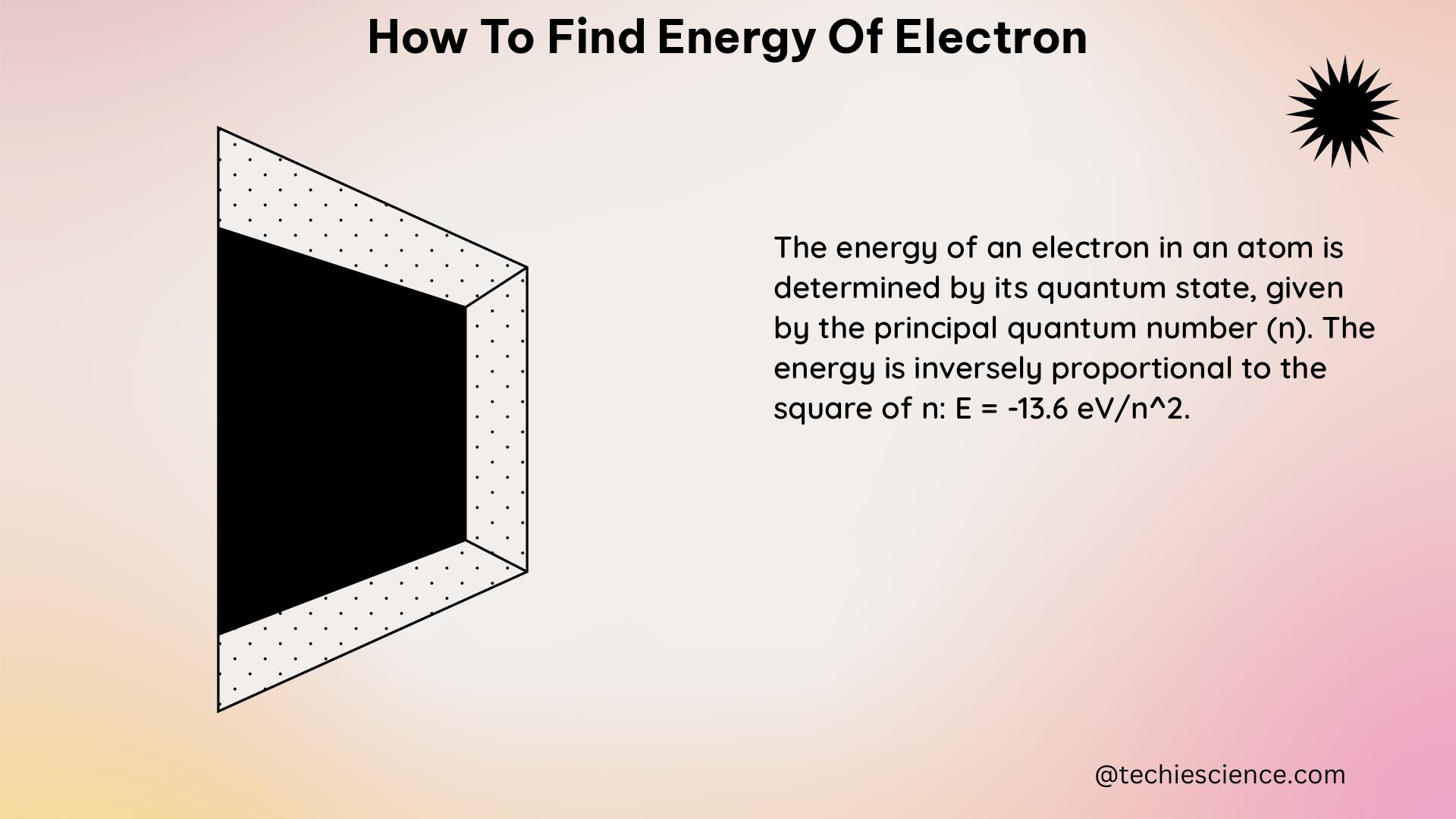Summary
Determining the energy of an electron is a fundamental concept in quantum mechanics and atomic physics. This comprehensive guide will provide you with the necessary tools and techniques to calculate the energy of an electron, including the formula for the change in energy, the conversion between electronvolts and joules, and the factors that can affect the energy of an electron, such as magnetic fields and temperature. We will also explore the behavior of electrons in quantum dots and the impact of various parameters on their energy states.
Understanding the Formula for the Change in Energy

The energy of an electron can be calculated using the formula for the change in energy of an electron jumping between energy levels:
ΔE = -13.6 eV(1/n^2_f – 1/n^2_i)
Where:
– ΔE is the change in energy of the electron, measured in electronvolts (eV)
– n_i is the initial energy level of the electron
– n_f is the final energy level of the electron
This formula is derived from the Bohr model of the atom, which describes the discrete energy levels of an electron in an atom.
Example Calculation
Let’s consider an example where an electron jumps from the fourth energy level (n_i = 4) to the first energy level (n_f = 1). The change in energy can be calculated as follows:
ΔE = -13.6 eV(1/1^2 – 1/4^2) = -13.6 eV(1 – 1/16) = -13.6 eV(15/16) = -13.6 x 15/16 eV = -1.875 eV
Converting Energy from Electronvolts to Joules
The energy of an electron can be measured in electronvolts (eV) or converted to joules (J) using the conversion factor:
1 eV = 1.6 x 10^-19 J
In the example above, the change in energy of -1.875 eV can be converted to joules:
ΔE = -1.875 eV x 1.6 x 10^-19 J/eV = -3.00 x 10^-19 J
Therefore, the energy of the electron in this example would be -3.00 x 10^-19 J or -1.875 eV.
Factors Affecting the Energy of an Electron
The energy of an electron can be influenced by various factors, including:
Magnetic Fields
In the presence of a magnetic field, the electronic states of an electron can be significantly modified. This is particularly evident in the study of quantum dots, where the addition energy of electrons can be affected by the magnetic field applied parallel to the tunneling current.
Temperature
The temperature of the system can also impact the energy of an electron. In some cases, the energy levels of an electron may shift or split due to thermal effects.
Quantum Dot Systems
Quantum dots are nanoscale semiconductor structures that can confine electrons in all three spatial dimensions. In these systems, the addition energy of electrons can be affected by factors such as the capacitance, gate voltage, and the number of electrons present.
Electron Addition Energy in Quantum Dots
The addition energy of electrons in quantum dots generally becomes larger as the number of electrons decreases. This is due to the complete filling of the first, second, and third shells, which correspond to certain values of N (such as N = 2, 6, and 12).
Magnetic Field Effects in Quantum Dots
The electronic states in quantum dots are also expected to be significantly modified by a magnetic field applied parallel to the tunneling current. This can lead to changes in the energy levels and the behavior of the confined electrons.
Practical Applications and Considerations
The understanding of electron energy is crucial in various fields, including:
- Atomic and molecular physics: Calculating the energy levels of electrons in atoms and molecules is essential for understanding their structure and behavior.
- Semiconductor devices: The energy of electrons in semiconductor materials, such as transistors and solar cells, plays a crucial role in their operation and performance.
- Quantum computing: The manipulation and control of electron energy levels are fundamental to the development of quantum computing and quantum information processing.
- Spectroscopy: The energy of electrons in atoms and molecules can be probed using spectroscopic techniques, providing valuable information about their structure and dynamics.
When working with the energy of electrons, it is important to consider the specific context and the relevant factors that may influence the energy levels. Careful experimental design and data analysis are essential to obtain accurate and reliable results.
Conclusion
In this comprehensive guide, we have explored the fundamental concepts and techniques for finding the energy of an electron. By understanding the formula for the change in energy, the conversion between electronvolts and joules, and the various factors that can affect the energy of an electron, you now have the necessary tools to accurately calculate and analyze the energy of electrons in a wide range of applications.
References
- Bohr, N. (1913). On the constitution of atoms and molecules. Philosophical Magazine, 26(151), 1-25.
- Kouwenhoven, L. P., Austing, D. G., & Tarucha, S. (2001). Few-electron quantum dots. Reports on Progress in Physics, 64(6), 701.
- Reimann, S. M., & Manninen, M. (2002). Electronic structure of quantum dots. Reviews of Modern Physics, 74(4), 1283.
- Beenakker, C. W. J. (1991). Theory of Coulomb-blockade oscillations in the conductance of a quantum dot. Physical Review B, 44(4), 1646.

The lambdageeks.com Core SME Team is a group of experienced subject matter experts from diverse scientific and technical fields including Physics, Chemistry, Technology,Electronics & Electrical Engineering, Automotive, Mechanical Engineering. Our team collaborates to create high-quality, well-researched articles on a wide range of science and technology topics for the lambdageeks.com website.
All Our Senior SME are having more than 7 Years of experience in the respective fields . They are either Working Industry Professionals or assocaited With different Universities. Refer Our Authors Page to get to know About our Core SMEs.